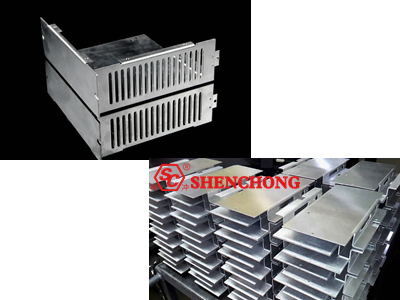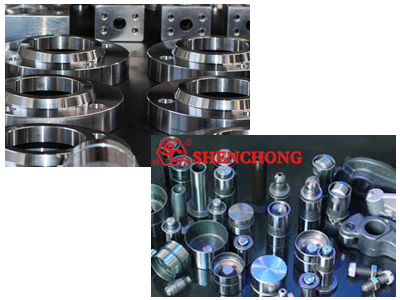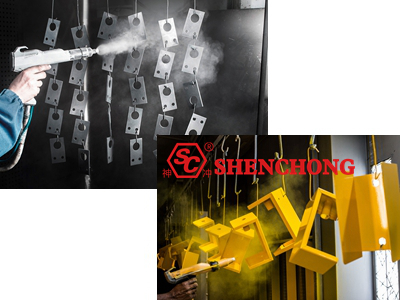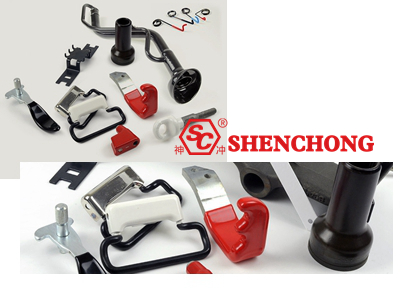

The purpose of sheet metal surface treatment:
In order to improve the service life in harsh environment: anti rust and anti-corrosion ability.
Meet the appearance requirements and achieve the required decorative effect.

In the electroplating solution, charged ions are attached to the surface of the product under the action of an electric field to form a coating.
Commonly used types of electroplating:
- Galvanizing: cyanide galvanizing, zincate galvanizing, chloride galvanizing and sulfate galvanizing
Galvanizing industry is a polluting industry. Although it is widely used and low cost, it does not meet ROHS standards. So try not to use electroplating products.
- Chromium plating: the process principle is the same as that of zinc plating.
Compared with traditional galvanizing, it has strong corrosion resistance, which is 7-10 times that of galvanizing. And the surface is beautiful, but the cost is high.
Powder spraying refers to a coating process in which powder coatings are adhered to the workpiece by corona discharge.
After powder spraying and then through hot melting, curing and other steps, a film will be formed on the surface of the workpiece.

Principle of powder spraying process:
Electrostatic powder spraying mainly polarizes the coating (powder) through the electrode, and then brings the opposite charge to the sprayed object. Under the action of electric field force, the powder is evenly attached to the surface of the object.
Features of powder spraying process:
Electrostatic powder spraying will not cause air pollution.
Powder can be recycled to reduce the consumption cost of materials.
Excellent coating performance.
The corrosion resistance of acid, alkali and salt is good.
Adhesion is also high.
Process principle of electrophoresis:
Electrophoresis process is divided into anodic electrophoresis and cathodic electrophoresis.
If the paint particles are negatively charged, the workpiece is the anode. The deposition of coating particles on the workpiece under the action of electric field force is called anodic electrophoresis.
Conversely, if the paint particles are positively charged, the workpiece is the cathode. The deposition of coating particles on the workpiece is called cathodic electrophoresis.
Characteristics of anodic electrophoresis:
Cheap raw materials (generally 50% cheaper than cathodic electrophoresis)
The equipment is simple (generally 30% cheaper than cathodic electrophoresis)
Low technical requirements
The corrosion resistance of the coating is worse than that of cathodic electrophoresis (about 1 / 4 of the service life of cathodic electrophoresis).
Reasons for high corrosion resistance of cathodic electrophoretic coating:
The workpiece is a cathode without anodic dissolution. The workpiece surface and phosphating film shall not be damaged.
Electrophoretic coatings (generally nitrogen-containing resins) have a protective effect on metals, and the paint used is of high price and high quality.
Process principle of plastic dipping:
Dip plastic alias, also known as plastic coating, hot dip plastic, hot compress plastic coating. Plastic dipping is a plastic coating process.
Plastic coating and plastic dipping can be divided into different raw materials.
Plastic impregnated products have been widely used in all aspects of production and life at home and abroad. Such as: our daily clothes hanger; Pliers, rubber sleeve on scissors, wrench of water valve, etc.

Process characteristics of plastic dipping:
Widely used
It has rich colors
Good protection
Excellent cold resistance, heat preservation, acid and alkali resistance
It oxidizes the metal on the surface of the workpiece. Thus, a dense protective film is formed on the surface of the workpiece to increase the corrosion resistance of the workpiece.
Generally, there are chemical oxidation and anodic oxidation. It is also a common sheet metal surface treatment process.
Process features of oxidation
Chemical oxidation:
low cost, high production efficiency, and quick results. It can be produced continuously in large quantities.
The process is stable. The operation is convenient. The equipment is simple. The solution is easy to maintain.
Part size and shape are not limited.
Chemical oxidation can be performed on steel, aluminum, copper, silver, zinc, tin, cadmium and their alloys.
Satisfactory results have also been obtained in functional applications. In recent years, chemical oxidation technology has been greatly developed.
Anodizing:
Higher cost.
Part size and shape affect power lines and current distribution due to the need for an external power source.
Commonly used in aluminum and its alloys, magnesium and its alloys, titanium and its alloys and other materials.
Film properties
Chemical oxidation:
Thin film. The general thickness is 0.5 to 4 microns.
Soft texture, no wear resistance, corrosion resistance and wear resistance are lower than anodic oxide film.
Some functional films that anodized films cannot have can be obtained. For example, conductive oxide film.
Anodizing:
Thick film.
Good corrosion resistance.
High hardness.
Some special functional films are available.
Surface wire drawing treatment is a sheet metal surface treatment method that forms lines on the surface of the workpiece by grinding the product, which has a decorative effect.
The surface drawing treatment can reflect the texture of metal materials, so it has been loved by more and more users and more and more widely used.
Advantages of surface wire drawing treatment:
Excellent wear resistance, high temperature resistance and corrosion resistance
Simple routine maintenance
Fine texture
Easy to clean
Long life
Purpose of surface wire drawing treatment:
Household appliance panel
Various digital product peripherals and panels
Laptop panel
It is used to make various signs
Membrane switch and nameplate, etc
Automatic Production Line: Sheet Metal Rolling And Welding Flexible Line
Imprinting and embossing is to place the plate between the upper and lower molds and change the material thickness under the action of pressure. The extruded material is filled in the convex and concave parts of the mold cavity with undulating fine lines.
Thus, undulating bulges and words or patterns can be obtained on the surface of the workpiece. For example, the coins and commemorative medallions currently used are formed by pressing.
Stamping and embossing processes are widely used in sheet metal parts, including label sticking position indication, product code, production date, version, manufacturer code, and even pattern, etc.
Imprinting is to change the thickness of the material, filling the extruded material in the undulating cavity, and forming undulating patterns or words on the part.
Generally, it is carried out in a closed mold to prevent the metal from being squeezed out of the mold cavity. For larger parts or parts with special shapes to be trimmed, it can be done in an open die.
In order to obtain a good surface quality of the parts, the blanks should be annealed, pickled, sandblasted, etc. before forming.
Embossing process is similar to imprinting, but the depth of deformation is small. The pressure required is also small.
Through spraying and high-temperature baking, it sprays various colors of coatings on the material surface to beautify the appearance and increase the anti-corrosion performance.
Generally, there are liquid baking paint and powder baking paint. Among them, powder baking paint is the most common. Its surface is not conductive. Paint baking is not allowed in areas with EMC requirements.
Baking paint is divided into two categories:
Low temperature baking paint, curing temperature is 140℃-180℃
High temperature baking paint, curing temperature is 280℃-400℃
Baking paint Advantages:
Bright colors and many styles.
Easy to clean and take care of.
A good baking paint door panel is much more UV resistant than a crystal door panel.
It has a certain lighting effect on increasing the space of the kitchen.
Paint baking disadvantages:
The production cycle is too long. The requirements of process level are high. And the scrap rate is high. So the price is high.
Fear of bumps and scratches. Once there is damage, it is difficult to repair and it should be replaced as a whole.
The color difference is easy to appear in the kitchen with more oil fume.